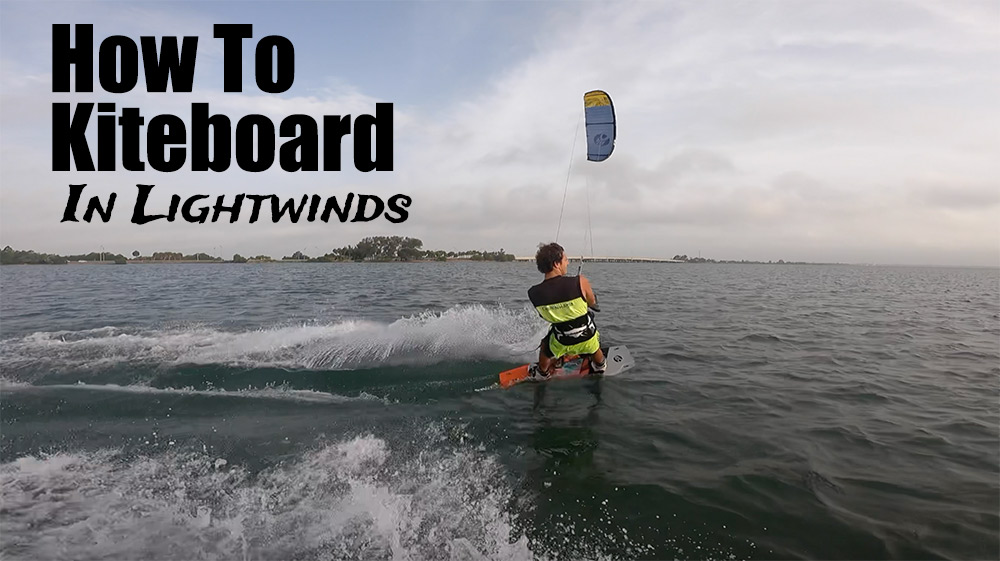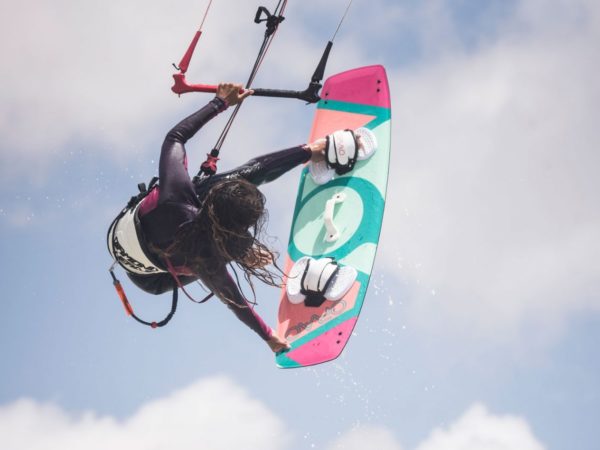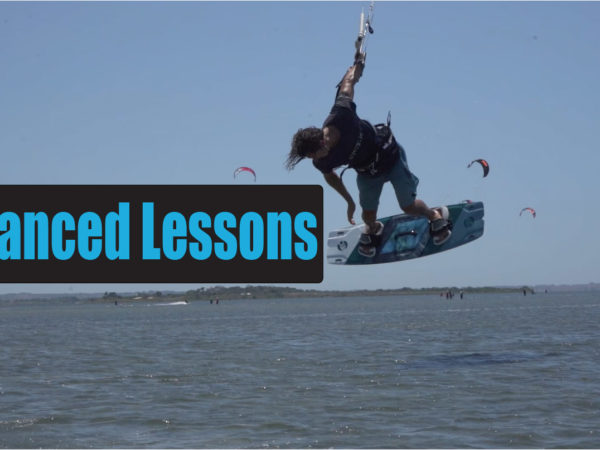How Light Can We Kiteboard?
Anything under 8 kts would be considered extremely lightwinds. In under 8 kts, kiteboarding kites will struggle to fly. It will be possible to fly, but it will be a challenge. For example, the kite will feel like there is no tension in the lines. A downloop can help in this situation to reposition the kite deeper into the wind window. Another common scenario is that the kite will fall out of the sky. There are some tricks for light wind water relaunching. Check out this video on extreme lightwind kiteboarding.
Kiteboard In Lightwinds
Size Matters
A rider’s weight significantly matters. The lighter a rider is, the lighter the winds they can kiteboard in. The ideal weight to be is under 200 lbs. Larger riders will struggle to get the power they need to create enough speed to kiteboard upwind. At 165 lbs, a 15m Cabrinha Contra is a fantastic kite to ride a twin tip and have fun in 10-14 kts of wind. For more information on weight and kite sizing check out Jame’s Kite Blog here.
Gear Matters
This article will not debate “the best” lightwind kite on the market. All the modern lightwind kites are efficient and better than they once were. What is important is how to tune a kite for lightwinds. One common mistake kiteboarders make in lightwinds is they stall the kite by sheeting the control bar in too much. If the control bar is out of tune, stalling will be more frequent. It is important to make sure the control bar is in tune. This means that all four lines should be equal in length when the bar is pulled in all the way.
Angle of attack matters. Refer to the image below for a visual representation of high verse low angle of attack. To keep it simple, kites with a high angle of attack are more prone to stall. Kites with a lower angle of attack are more likely to fly in lighter winds. Tune the kite to have a lower angle of attack for lightwinds. If the bridle for the outside steering lines has multiple knot options, select the knot furthest away from the kite. If there is only one knot option, depower the kite from the control bar. Depowering the kite will pull the two center lines in closer creating a similar affect as using the outside knot on the bridle steering lines.
Launching a Kite in Lightwinds
There are two safe methods to launching a kite in lightwinds. A kiteboarder could launch with the assistance of another kiteboarder or perform a drift launch. To launch with the assistance of another kiteboarder requires knowledge of the wind window. We always recommend starting slightly downwind of perpendicular to the wind window.
With someone holding the kite, walk into the wind until the kite stops fluttering. In lightwinds the kite will be deeper into the wind window than normal conditions. Once the kite stops fluttering and the person assisting lets go, continue to walk into the wind. Many beginner kiteboarders walk away from the kite thinking that more tension will help. The reality of this situation is that the person is keeping the kite at the edge of the wind window where there is less wind to get the kite to fly. Walking directly into the wind positions the kite deeper into the wind window where there is more wind to catch the kite to go up.
Balance tension in the control bar as the kite goes up. Lightwinds is a true test of balancing bar tension. Too much tension in the control bar and the kite stalls. Too little tension in the control bar and the kite does not respond. Lightwinds are a true test of how to balance the right amount of tension. And the key point to balancing tension is to keep a relaxed grip on the control bar.
Water Relaunches in Lightwinds
Putting a kite in the water in lightwinds is often game-over for the kiteboarder. There is a trick to water relaunching in almost no wind. In order to do this trick, the control bar has to have a “low V”. In other words, where the two center lines split has to be within arms reach of the chickenloop. The trick to lighwind water relaunches is to roll the kite onto its side. This can be done by pulling the opposite center line of the outside steering line. It takes finesse and technique, but is highly effective.
How to Waterstart in Lightwinds
Everything goes back to understanding the wind window. To waterstart in lightwinds the kite needs to go deeper into the wind window. One technique is to bring the kite slightly in the opposite direction before initiating a power stroke. Another way to look at this is if riding to the right, initiate the dive with the kite at 11 o’clock. This technique will cause the kite to go deeper into the wind window causing more power to be generated on the dive.
Steering appropriately is another fundamental aspect that will help waterstart in lightwinds. Pulling as hard as one can will not help. What will help is steering the kite more aggressively. This can be done by pulling one side of the bar in and pushing the other side of the bar out. Wait until there is a pull from the harness before steering the kite back up. In lightwinds the kite may need to travel further down or closer to the water before generating the power to get up.
Another technique to waterstart in lightwinds is to do a downloop on the waterstart. The downloop will cause the kite to go through the apex of the wind window. This will generate the maximum amount of power. For this trick it is important to be upwind and away from any obstacles.
How to Ride Upwind in Lightwinds
The final task the can be challenging is to ride and stay upwind. It takes skill to ride a twintip upwind in lightwinds. These skills can translate over to being a more efficient kiteboarder. As a more efficient kiteboarder, one can jump higher and make the most of their kite. A big board, larger than 145cm, will make it easier to ride upwind.
The key skill to have for riding upwind in lightwinds is to create speed. Speed can be created from getting the kite deeper into the wind window on a waterstart. Once the kite is deep in the wind window, it is important to keep it there. The kite can be kept there by maintaining tension in the control bar. If the control bar is pushed out too much, the kite will travel towards the edge of the wind window and the power gained will be lost. In this situation, the rider will have to bring the kite back up to 12 o’clock and initiate another aggressive power stroke.
Board angle matters! If a rider travels too far downwind, then there is not enough tension between the rider and the kite to generate power. If the the rider points too far into the wind, then they are pushing water and are in a stopped position. The key is to travel crosswind and then ride slightly into the wind once speed is created.
A technique to ride upwind is to “pump the board”. Pump the board by pushing down on the back foot and cutting slightly into the wind. Find a rhythm and cadence to create and generate speed.
General Lightwind Kiteboarding
Everything has to work in unison and is tested in lightwinds. The equipment and skills need to be dialed in to make the most of the lighter wind conditions. The equipment helps, but the skills are a necessary component. Creating the skills to kiteboard in lightwinds will help every other aspect of the sport.
This post has been dedicated towards kiteboarding in lightwinds with a twintip, but a foilboard provides even more lightwind performance. Kiteboarding in lightwinds with a foilboard deserves an article of its own. But, the skills needed behind the kite translate between a twintip and foilboard.
Learn how to Kiteboard in Lightwinds
Maybe you are a beginner, intermediate or a more advanced rider and want to perfect your lightwind skills. Schedule a lesson with us to learn a variety of different techniques for when the winds are blowing 10-14kts.
Notice: JavaScript is required for this content.
<!–
–>
!function(f,b,e,v,n,t,s){if(f.fbq)return;n=f.fbq=function(){n.callMethod?
n.callMethod.apply(n,arguments):n.queue.push(arguments)};if(!f._fbq)f._fbq=n;
n.push=n;n.loaded=!0;n.version=’2.0′;n.queue=[];t=b.createElement(e);t.async=!0;
t.src=v;s=b.getElementsByTagName(e)[0];s.parentNode.insertBefore(t,s)}(window,
document,’script’,’https://connect.facebook.net/en_US/fbevents.js’);
fbq(‘init’, ‘1777067532515835’); // Insert your pixel ID here.
fbq(‘track’, ‘PageView’);
(function(d, s, id) {
var js, fjs = d.getElementsByTagName(s)[0];
if (d.getElementById(id)) return;
js = d.createElement(s);
js.id = id;
js.src = "//connect.facebook.net/en_US/sdk.js#xfbml=1&version=v2.5";
fjs.parentNode.insertBefore(js, fjs);
}(document, 'script', 'facebook-jssdk'));
Source link
Ähnliche Beiträge
Related Posts
Trip nach Stradbroke Island, Queensland, Australia
Niemand Geringeres als James Cook entdeckte die Insel im Jahre 1770 – aber er segelte vorbei und ließ das Eiland namenlos. Erst im Jahre 1827 benannte Henry John Rous es nach seinem Vater, dem Earl of Stradbroke. Ursprünglich...



